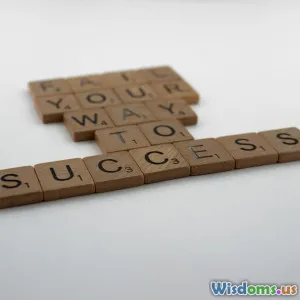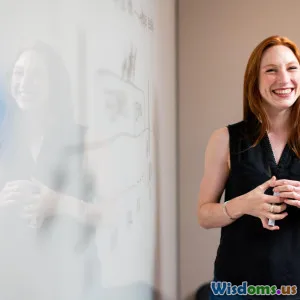
How to Set Career Goals That Actually Motivate You Every Day
13 min read Discover practical steps to set impactful career goals that keep you inspired and productive every day. (0 Reviews)
How to Set Career Goals That Actually Motivate You Every Day
Setting career goals isn’t just a box we check off during annual reviews. When chosen wisely and aligned with your ambitions, the right goals foster clarity, resilience, and daily motivation. However, many people set vague or uninspiring goals, leading to personal stagnation and disengagement. Let’s shift to a smarter, more meaningful approach that transforms your career goals into an energizing part of your daily routine.
Understand the Why Behind Your Ambitions

Before you even grab a notebook or open your digital planner, ask yourself why you want to achieve something. Goals anchored in external expectations or generic standards—think "get promoted within 2 years"—often feel flat. Conversely, when a goal ties directly to your internal drivers, it provides authentic motivation and resilience against setbacks.
Example: Sarah, a junior software developer, initially set the goal: “Become a team lead within a year.” But after reflecting on what truly motivates her, she realized her deeper passion lay in mentoring and helping others grow. She reframed her goal to: "Guide and onboard two new developers within the next 12 months." This tangible, personally meaningful objective energized her daily, turning interactions into opportunities.
How to Identify Your 'Why':
- Reflect on career moments that felt meaningful—what patterns emerge?
- Ask: "If no one was watching or judging, what work would I love to do?"
- Consider your values: autonomy, impact, innovation, relationships, security?
Insight: Once you know your 'why', metrics and milestones feel far more relevant. Career expert Simon Sinek's famous advice, “Start With Why,” isn’t just a slogan—it's a proven motivator.
Make Goals Specific, Measurable—But Not Overbearing

If a goal lacks clarity or measurable progress, motivation fizzles. But beware: micromanaging every milestone can sap joy. The secret lies in balancing specificity with flexibility.
- Vague Goal: "Excel in my job this year."
- Specific Goal: "Increase client satisfaction scores from 80% to 90% by December."
Set SMARTER, Not Just SMART Goals
The SMART framework (Specific, Measurable, Achievable, Relevant, Time-bound) is a foundation, but researchers at the University of East London found adding two extras—Energizing and Rewarded—makes a difference. Ask:
- Energizing: Does this goal make me excited to show up each day?
- Rewarded: Will I feel accomplished as I progress, not just at the finish line?
Example: Instead of aiming only for a promotion, set micro-goals like “contribute to a high-profile project” or “mentor a colleague.” These are measurable, energizing, and let you appreciate incremental wins.
Personalize Your Progress Markers
Motivation grows when you monitor changes that matter to you. Progress shouldn't be defined by generic checklists, but by milestones you find meaningful. The key is to establish personal benchmarks and celebrate progress, not perfection.
Tips for Building Better Progress Markers:
- Break Down Big Goals: Divide your primary goal into milestones. If your aim is “become a senior analyst,” set steps like “lead two projects,” “present at industry events,” or “build data visualization skills.”
- Choose Metrics You Control: While some outcomes depend on others (like job offers), focus on actions within your control, like number of applications sent or new skills gained.
- Adopt Reflective Review Cycles: Research shows that those who track achievements weekly tend to be more persistent. Try a Friday review: What did I do well? What grows my confidence for next week?
Insight: Athletes and artists obsessively review micro-improvements in technique—professionals can leverage the same habit for career growth.
Connect Goals to Identity, Not Just Outcomes

People are more likely to stick to goals aligned with their self-concept. Instead of pursuing goals solely for results—a raise, a title, an award—connect them to the kind of professional you want to be.
Example: If you see yourself as an innovator, set goals around implementing new ideas, leading hackathons, or piloting a project with emerging tools. If you value service, aim to improve customer feedback scores, train others, or start a knowledge-sharing session in your team.
Professional Role Models:
-
Angela Duckworth, psychologist and author: She urged aspiring leaders to craft "identity-based" goals (e.g., "Be a reliable mentor") over purely achievement-based ones. Her research links this approach to longer-lasting motivation.
-
LeBron James (athlete): Known not just for his stats, but his identity as a mentor and leader in and out of basketball. His daily motivation comes from pursuing this broader identity.
Build Feedback Loops and Support Systems

Motivation thrives in communities. Going it alone makes it far tougher to stay the course—plus, outside feedback can reveal strengths or blind spots you might miss.
How to Harness Feedback Effectively:
- Find Accountability Partners: Regular check-ins with a peer or mentor boost follow-through. A Harvard study found public commitments nearly double success rates.
- Seek Constructive Criticism: Don’t just wait for annual reviews. Request feedback after projects, presentations, or milestones.
- Participate in Professional Groups: Whether it's a meetup, industry Slack group, or internal brown-bag session, outside perspectives foster fresh energy and ideas.
Real-World Example: A marketing manager named Carlos formed a monthly dinner group with industry friends, each sharing one career goal and progress update. Over time, each member advanced faster—lateral hops, big projects, or major pivots—highlighting how community multiplies motivation.
Blend Ambitious and Attainable Goals

Bold goals are exciting, but realism keeps morale high. Somewhere between "play it safe" and "shoot for the stars" lies the sweet spot for daily motivation. The best goals have intrinsic stretch (pushing your boundaries) but remain believable.
Pro Tips for Healthy Ambition:
- Aim for Growth Zone, Not Burnout Zone:
- Out of your comfort zone, but not so far that motivation crumbles from overwhelm.
- Mix Immediate and Long-Term Targets:
- Combine swift wins (present ideas to the team next month) with major ambitions (land a leadership role in 3 years).
- Regular Course Correction:
- Quarterly, reassess: Is the goal too easy? Too hard? Motivation drops on both ends of the spectrum.
Example: An entry-level financial analyst, Priya, set a daunting goal: “Become department head in three years.” After the first year brought more stress than satisfaction, she recalibrated to "Take the CFA Level 1 exam this year and lead a team project within six months." This kept her engaged and built momentum for bigger ambitions later.
Infuse Daily Work With Purpose—Micro-Motivation Tactics

Motivation is cultivated in the trenches. It’s not just the goals you set, but the habits and rituals that make progress habitual, not forced.
Practical Strategies:
- Morning Intention Setting: Each morning, choose 1-2 meaningful actions that move you closer to your goal (“Today, I’ll reach out to a new professional contact.”)
- Visual Tracking: Posted progress trackers, digital dashboards, or even a sticky note journal, help you see movement (even if small!)
- Celebrate Micro-Wins: Finish an important email? Solved a client issue? Find a way to reward yourself—a quick walk, a favorite coffee, or sharing the win with a peer.
- Reframe Setbacks: Not every day will feel productive. Instead of discouragement, view missteps as learning. University of Chicago researchers found persistence grows in those viewing failures as part of progress.
Example: Jean, in nonprofit fundraising, keeps a jar of "daily wins"—every time she achieves something aligned with her career growth, she scribbles it on a note. Reading the pile every Friday keeps her passion high.
Revisit and Revise Your Goals Regularly

Life and interests evolve. Goals set a year ago may no longer burn brightly—and that’s natural. Neglecting to update them is like following a map for a town you no longer live in.
Career Case Study: Mel, a UX designer, found her role morphing due to industry shifts. Instead of stubbornly clinging to old markers ("launch three consumer apps"), she shifted to “collaborate with researchers on AI-powered design solutions.” This reframing restored her excitement and provided new learning opportunities.
How (and When) to Recalibrate:
- Monthly Check-ins: Are you still excited? If not, why? Have your passions or circumstances changed?
- Solicit Feedback: Are colleagues, managers, or your industry suggesting different priorities?
- Let Go Guilt-Free: Dropping a stalling goal isn’t quitting; it's making space for more relevant ambitions.
Insight: Pro athletes, CEOs, and Nobel laureates revise their goals repeatedly—it's the mark of adaptive, high performers.
Crafting and pursuing career goals isn’t about discipline alone; it’s about kindling your motivation through clarity, personal meaning, the right balance of stretch, and communities of support. If a goal isn’t pulling you forward each day, dig deeper: align it with your ‘why’, break it down, track progress, seek feedback, and adapt as you grow. In doing so, motivation ceases to be something you have to force—instead, it becomes part of the journey itself.
Rate the Post
User Reviews
Popular Posts


















